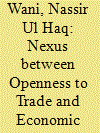|
|
|
Sort Order |
|
|
|
Items / Page
|
|
|
|
|
|
|
| Srl | Item |
| 1 |
ID:
193050


|
|
|
|
|
| Summary/Abstract |
The idea that regional integration is the podium of economic growth dates back a long time. Even now, a plethora of literature confirms a strong and positive link between regional integration and economic growth. However, most of these studies are focused on developed countries. Indeed, literature from developing countries is scant, and that from underdeveloped and landlocked countries like Afghanistan is almost non-existent. In the context of South Asian Free Trade Agreement, this article endeavours to innovatively scrutinize the trends in exports, imports and trade at different industry levels in the trade specialization of Afghanistan. At the harmonized standard 6-digit level of product classification, the study has employed the Lafay Index approach. The study finds that Afghanistan has a greater affinity for resource-intensive manufacturing products and non-fuel primary commodities. The study suggests that Afghanistan should confront issues such as its trade deficit, its dependency on agricultural products for export and the underutilization of its natural resources. The results show that Afghanistan still has a competitive disadvantage over South Asian Association for Regional Cooperation (SAARC) members at different industry levels. The study recommends dealing with problems including technology diffusion, product diversity and quality sophistication at various industrial levels, which restrict a higher degree of trade specialization.
|
|
|
|
|
|
|
|
|
|
|
|
|
|
|
|
| 2 |
ID:
168504


|
|
|
|
|
| Summary/Abstract |
The notion that the international trade is the foundation of economic growth dates long back, and even now, an irresistible body of literature confirms a strong and positive link between trade openness and economic growth. However, most of these studies are focused on developed countries. Indeed literature from developing countries are scant, those from under developed and a landlocked country like Afghanistan are almost non-existent. This article endeavours to innovatively scrutinize the relationship between trade liberalization and economic growth in Afghanistan, using biannual data for the period 1995–2016 and thus evaluates the comparative effect of three different measures of trade openness on the economic growth by using more rigorous econometric techniques. Autoregressive distributed lag (ARDL) method, JJ CO-integration and ordinary least square (OLS) results suggest significant positive long-run relationship between export and economic growth. In contrast, total volume of trade and imports have significant negative effect on the economic growth. The addition of variables and results of fully modified OLS suggest that the results are robust. The Granger causality and variance decomposition analysis indicate the unidirectional causality between trade openness and economic growth. In export model, causality runs from export to growth. Whereas, in the model with total volume of trade and import, causality runs from growth to total volume of trade and imports in Afghanistan. From the findings, it is concluded that the policymakers should focus on export promotion strategy to enhance the economic growth in Afghanistan. Besides, efficient utilization of capital goods should be ensured and reliance on non-capital goods should be less in order to ensure high domestic production in the country.
|
|
|
|
|
|
|
|
|
|
|
|
|
|
|
|
|
|
|
|
|